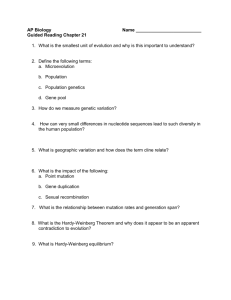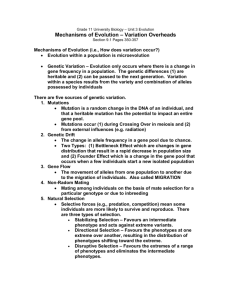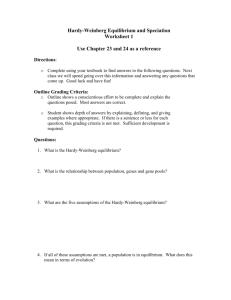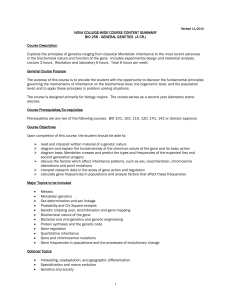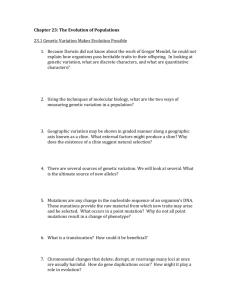New Lecture 2.9 (Evolution).docx
advertisement
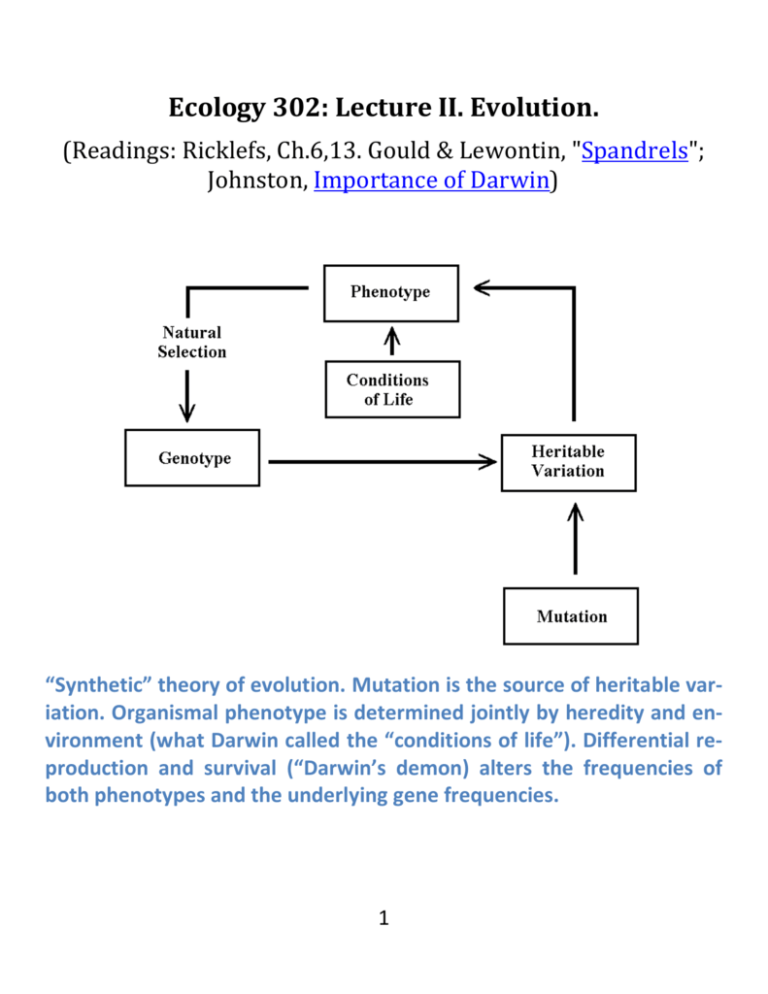
Ecology 302: Lecture II. Evolution. (Readings: Ricklefs, Ch.6,13. Gould & Lewontin, "Spandrels"; Johnston, Importance of Darwin) “Synthetic” theory of evolution. Mutation is the source of heritable variation. Organismal phenotype is determined jointly by heredity and environment (what Darwin called the “conditions of life”). Differential reproduction and survival (“Darwin’s demon) alters the frequencies of both phenotypes and the underlying gene frequencies. 1 Key Points. • Darwinism a theory of competition. • Rediscovery of Mendelism facilitated fusion of the DarwinWallace selection theory and genetics. • Modern Synthesis essentially a theory of gene frequencies and factors that affect them. • Consequences of diploidy. • Hardy-Weinberg equilibrium and deviations therefrom. • Absent mutation / migration, inbreeding increases with consequent loss of genetic diversity. • Selection changes gene frequencies so as to maximize . • Quantitative genetics appropriate for metric characters under polygenic control. • Heritability, 1 ⇒ “reversion to the mean”. 2 • Effective population size reflects deviations of realworld population properties from those of an ideal population. • Reaction norms map environment into phenotype. • Adaptive “transgenerational effects” consequent to extrachromosomal (epigenetic) inheritance. • Adaptive scenarios, while appealing, should be weighed against non-adaptive alternatives. 3 I. Theory of Natural Selection. A. Variability. 1. Some variations heritable. 2. Of these, some affect fitness. B. Excess reproduction – Principle of Malthus. C. A + B => Descent with modification (DwM). D. As articulated by Darwin / Wallace, a theory of competition. Figure 1. Substitution of an advantageous mutant in a haploid. N1* and N2* are equilibrium densities of wild type and mutant populations. a. Per capita rates of increase (births – deaths) plotted against population size. For all densities, the mutant outperforms the original. b. Numbers of the two vs. time. Arrow marks origination of the mutant. 4 E. Rediscovery of particulate inheritance made possible 1. Reconciliation of the “selection theory” and inheritance – solved the loss of variability problem. 2. Elaboration of the “Modern Synthesis” after WWI. F. “Modern Synthesis” holds that 1. Population genetics central; evolution is changing gene frequencies. 2. Mutation the source of heritable variation. 3. Mutation rates affected by environment but random with regard to fitness consequences. 4. “Stuff” of evolution is mutations of small effect; mutations of large effect almost always deleterious. 5. Natural selection the sole creative force. 6. Sequential fixation of beneficial mutants solves the “monkey typing Shakespeare” problem. See http://www.blc.arizona.edu/courses/schaffer/182/g eorge.htm . 5 G. Synthesis rejects 1. Saltatory change, i.e., evolution by “hopeful monsters”. 2. Direct environmental induction of heritable adaptive traits (accepted by both Darwin and Lamarck). 3. Inherent tendencies to a. Increasing perfection / complexity (Lamarck’s “Power of Life”). b. “Evolutionary momentum” (orthogenesis) and its consequences (directional evolution; “racial senescence”) as observed, for example, in the evolution of horses. 6 II. Factors that Affect Gene Frequencies. A. Selection. 1. Directional 2. Stabilizing 3. Disruptive. 4. See Ricklefs, pp. 119-23 for examples: Darwin’s finches; scale insects, etc. Figure 2. Different modes of selection on a quantitative trait. B. Mutation 1. Ultimate source of new variation. 2. Maintains deleterious alleles (that sometimes later become advantageous) in the face of selection (mutation-selection balance). C. Migration 1. Another source of variation. 2. The “glue” that holds populations together. D. Population size. Stochastic loss of genetic diversity (“drift”) inversely related to population size. 7 E. Diploidy introduces new possibilities. 1. Retards elimination of deleterious recessives, 2. Heterozygote advantage – maintains genetic diversity – e.g., sickle cell gene in presence of malaria. 3. Heterozygote inferiority – initial frequencies determine the outcome. 8 III. Mendelian Population Genetics. A. Hardy–Weinberg (HW) Law. 1. Relates genotypic frequencies to gene frequencies 2. Assumes a. Infinite, panmictic populations. b. No other forces operative. 3. Under these conditions, H-W frequencies established in a single generation. 9 Top. H-W frequencies result from random mating between male and female parents. Bottom. Genotypic vs. gene frequencies. 4. For one locus and two alleles: A, a, with frequencies p and q: : : : 2: (1) In finite populations, one encounters an excess of homozygotes that (again absent other forces) increases from one generation to the next. ; 2 2 (2) 1. Inbreeding coefficient, F, a measure of homozygote excess. 2. Often estimated from heterozygote deficiency !"#$ !"%&' !"#$ (3) 3. Absent new genetic variation, excess homozygosity, and hence F, increases with time. 10 4. Define index of panmixia () 1 ) (4) 5. It can be shown that 1 ) () *1 + ⇒ lim () 0; lim ) 1 )→/ )→/ 2 (5) 6. Expected time to homozygosity (coalescence time) is 4N generations. 7. Loss of variation ⇒ inbreeding depression. 8. With recurrent mutation, ) → 1 where 1 1 43 1 and μ is the mutation rate. 11 (6) B. Response to Selection. 1. In the case of one allele and two loci, change in gene frequency, ∆, given by 7 51 6 8 ∆ 7 8 2 (7) where p is the frequency of one allele, and 7 9 251 69 51 6 9 (8) is mean fitness of the population. 2. Eq 7 assumes H-W frequencies (weak selection). 3. Eq 7 => three possible equilibria: 0; 1; 0 ∗ 1 12 (9) a. Third possibility requires that 7 ;$ = ;< <><∗ 0 (10) b. Eq 7 => gene frequencies change so as to increase . Fitness Relations Response 9 ? 9 ? 9 ) → 1 9 9 9 ) → 0 9 9 ? 9 ) → ∗ , 0 ∗ 1 9 ? 9 9 ) → 0 or B) → 1 13 Figure 3. Under selection, gene frequencies (left) change so as DDD (right). Shown here are the four cases in Table to maximize C 1. 14 C. Adaptive Topographies. 1. With multiple fitness peaks, a population can be stranded on one peak even though “jumping” to another would increase fitness. 2. Figure 4. 1-D fitness landscape. Selection can keep the popula“Peak hopping” faciltion in the vicinity of one of the itated by two adaptive peaks. a. Increased within-population variability; b. Small population size, which facilitates stochastic variation in gene frequencies (drift). c. Environmental shifts whereby a population near one adaptive peak finds itself on the slope of a different peak. 3. Key Point: Tension between deterministic and random forces. 15 Figure 5. Evolution on a 2-D adaptive landscape. Dotted lines are contours of equal fitness. Plus signs indicate fitness maxima; minus signs, minima. Left. Increased mutation or reduced selection leads to increased genetic variability. Center. Increased selection or reduced mutation reduces variability. Right. An environmental shift can place a population on a new peak, which selection then causes the population to climb. Reduced population size has the same effect as increasing mutation / reducing selection. From Simpson. 1944. Tempo and Mode in Evolution. 16 IV. Quantitative Inheritance. A. Most so-called “metric traits” controlled by multiple alleles. 1. Length, weight, etc. 2. Agricultural yields. B. The stuff of micro-, but probably not macro-evolution. C. Character distribution often approximately normal. E 1 F√2H ! I 5JIK6L M L (11) D. Quantitative genetics partitions phenotypic variance into genetic and environmental component, and further subdivides genetic variance. 17 E. Heritability, h2, of a trait, is the slope of the regression, offspring trait value vs. parent value. 1. Expected offspring trait value given by Figure 6. Offspring vs. parental height as determined by Sir Francis Galton in 1889. N%OO ND PND<Q NDR (12) 2. 1 ⇒ “reversion to the mean”. 3. High heritability does not necessitate that variation in the character in question is largely under genetic control. 18 F. Following truncation selection, established but shifted. distribution Figure 7. Re-establishment of trait distribution after truncation selection. 19 re- G. Historical note: Demonstration1 by R. A. Fisher that “continuous” variation of metric traits consistent with polygenic control 1. Made possible the reconciliation (Modern Synthesis) of Mendelian genetics and Darwin-Wallace theory. 2. Rescued Darwinism from history’s ash heap. Table 2. Mendelian vs. Quantitative Genetics. Within Genotype Between Genotype Variability Variability Mendelian Small Large Quantitative Large Small Appropriate Genetic Model 1. 1918. The correlation between relatives on the supposition of Mendelian inheritance. Phil. Trans. Roy. Soc. Edinburgh. 20 V. Finite Population Effects. A. Hardy-Weinberg frequencies only obtain in the limit of infinite population size. B. In a finite population, one observes an excess of homozygotes. C. Genetic drift ⇒ loss of genetic diversity and the fixation of maladaptive Figure 8. Simulation of genetic alleles. 1. drift of 20 unlinked alleles in populations of 10 (top) and 100 Results from the (bottom). Loss of alleles is more probabilistic na- rapid in the smaller population. ture of births and deaths. 2. Most important in small populations in presence of weak selection. 21 D. Selection vs. Drift. 1. Probability of a mildly beneficial mutation’s being fixed is ~2s, where s is the selective advantage. 2. Probability of al- Figure 9. For N = 500,-3selection dominates drift if s » 10 . lelic fixation by chance is 1/2N. 3. Then selection more important than drift if 1 S≫ 2 22 (13) VI. Effective Population Size, UV . A. Ideal population characterized by 1. Random mating 2. Equal numbers of males and females 3. Constant population size. B. , the size of an ideal population with same properties of the real one. C. Factors that reduce . 1. Assortative mating (likes mate with likes) – homozygotes accumulate in excess of HW proportions. 2. Unequal sex ratio. 3. Fluctuating populations – Special cases: bottlenecks, founder effect. 23 VII. Phenotypic and Developmental Plasticity. A. Behavioral. Individual responses to environmental stress promote homeostasis. 1. Diurnal variations in behavior. 2. Seasonal variation in diurnal rhythms. 3. Commonly observed in, but not restricted to, poikilotherms. B. Development. Reaction norms (RNs). 1. RNs map environment into phenotype (Fig. 10). 2. RNs often dffer bewtween genotypes 24 Figure 10. Linear reaction norm (hypothetical). 3. Between-population differences in RNs can be adaptive responses to differences in average prevailing conditions. Figure 12. Schematic illustrating adaptive variation in reaction norms of two populations raised under different conditions. Individuals have greater fitness in the environment in which they were raised and reduced fitness in the other environment, 25 VIII. Direct Environmental Induction. A. Maternal exposure to environmental triggers can induce adaptive changes in offspring. B. Trigger often a chemical released by predators. C. Examples. 1. Immobile crickets – avoid wolf spiders. Figure 13. Colored scanning elec2. tron micrograph of different Helmeted water forms of the water flea Daphnia fleas – frustrate cucullata. Left. Standard shape. predatory Chaobo- Right. Predator-induced morph with helmet (green) and tail rus larvae. (blue). From Sciencephoto.com. D. In some cases, effects transgenerational E. Mechanism appears to be epigenetic, e.g., changes in DNA methylation, that affect gene expression. 26 XI. Evolution and The Adaptationist’s Programme. A. Theory of evolution really two theories. 1. Descent with modification (DwM) – the macroscopic pattern. 2. (Heritable) Variation plus selection (VpS) – the presumptive proximate mechanism. Figure 16. Phylogenetic descent as envisaged by Lamarck in his Philosophie Zoologolique (1809). Infusoria (protists), (hydras) polyps and radiaria (jellyfish) form one group. All other animals descend from worms. B. With regard to DwM, evidence has continued to accumulate since the days of Lamarck. C. With regard to mechanism, ideas have continued (and are continuing) to change. 27 D. George no longer limited to typing one letter at a time. E. Desire to shoehorn observations into adaptive scenarios understandable. But … 1. 2. The evidence is often weak. Figure 17. Spandrel in St. Mark’s non- cathedral in Venice. There are adaptive alternatives – see Gould and Lewontin. 28

